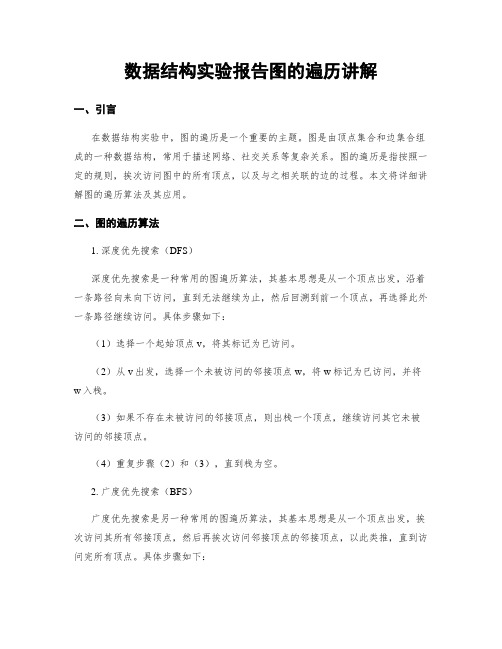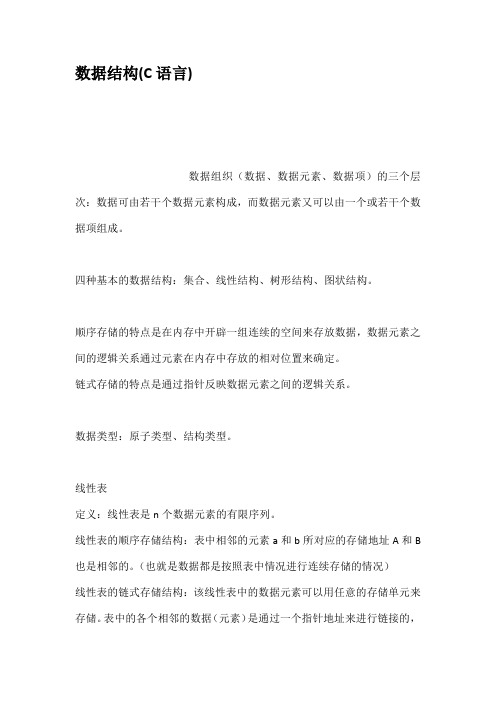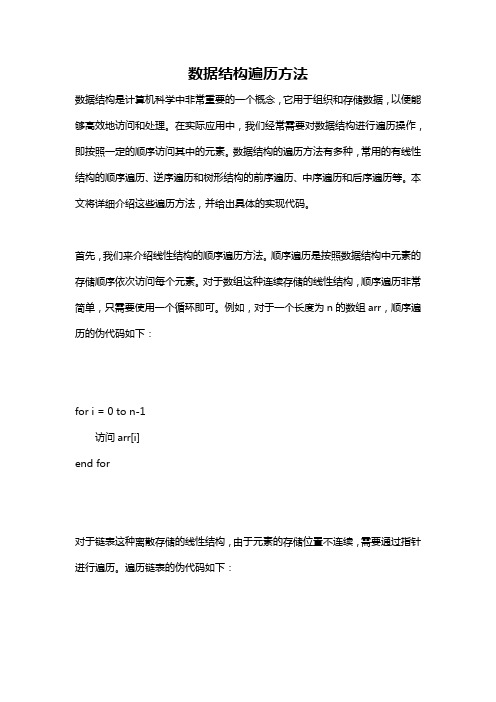数据结构C语言版 图的建立与遍历
数据结构实验报告图的遍历讲解

数据结构实验报告图的遍历讲解一、引言在数据结构实验中,图的遍历是一个重要的主题。
图是由顶点集合和边集合组成的一种数据结构,常用于描述网络、社交关系等复杂关系。
图的遍历是指按照一定的规则,挨次访问图中的所有顶点,以及与之相关联的边的过程。
本文将详细讲解图的遍历算法及其应用。
二、图的遍历算法1. 深度优先搜索(DFS)深度优先搜索是一种常用的图遍历算法,其基本思想是从一个顶点出发,沿着一条路径向来向下访问,直到无法继续为止,然后回溯到前一个顶点,再选择此外一条路径继续访问。
具体步骤如下:(1)选择一个起始顶点v,将其标记为已访问。
(2)从v出发,选择一个未被访问的邻接顶点w,将w标记为已访问,并将w入栈。
(3)如果不存在未被访问的邻接顶点,则出栈一个顶点,继续访问其它未被访问的邻接顶点。
(4)重复步骤(2)和(3),直到栈为空。
2. 广度优先搜索(BFS)广度优先搜索是另一种常用的图遍历算法,其基本思想是从一个顶点出发,挨次访问其所有邻接顶点,然后再挨次访问邻接顶点的邻接顶点,以此类推,直到访问完所有顶点。
具体步骤如下:(1)选择一个起始顶点v,将其标记为已访问,并将v入队。
(2)从队首取出一个顶点w,访问w的所有未被访问的邻接顶点,并将这些顶点标记为已访问,并将它们入队。
(3)重复步骤(2),直到队列为空。
三、图的遍历应用图的遍历算法在实际应用中有广泛的应用,下面介绍两个典型的应用场景。
1. 连通分量连通分量是指图中的一个子图,其中的任意两个顶点都是连通的,即存在一条路径可以从一个顶点到达另一个顶点。
图的遍历算法可以用来求解连通分量的个数及其具体的顶点集合。
具体步骤如下:(1)对图中的每一个顶点进行遍历,如果该顶点未被访问,则从该顶点开始进行深度优先搜索或者广度优先搜索,将访问到的顶点标记为已访问。
(2)重复步骤(1),直到所有顶点都被访问。
2. 最短路径最短路径是指图中两个顶点之间的最短路径,可以用图的遍历算法来求解。
数据结构(C语言版)

比较
Prim算法适用于稠密图, Kruskal算法适用于稀疏图;
两者时间复杂度相近,但 Kruskal算法需额外处理并查
集数据结构。
最短路径算法设计思想及实现方法比较
1 2
Dijkstra算法
从源点出发,每次找到距离源点最近的顶点并更 新距离值,直至所有顶点距离确定。适用于不含 负权边的图。
Floyd算法
特殊二叉树
满二叉树、完全二叉树等。
二叉树的遍历与线索化
二叉树的遍历
前序遍历、中序遍历、后序遍历和层 次遍历是二叉树的四种基本遍历方法 。
线索化二叉树
为了方便查找二叉树节点的前驱和后 继,可以对二叉树进行线索化处理, 即在节点的空指针域中存放指向前驱 或后继的指针。
树和森林的遍历与转换
树的遍历
01
串的顺序存储结构
01
02
03
串的顺序存储结构是用 一组地址连续的存储单 元来存储串中的字符序
列的。
按照预定义的大小,为 每个定义的串变量分配 一个固定长度的存储区 ,一般是用定长数组来
定义。
串值的存储:将实际串 长度值保存在数组的0下 标位置,串的字符序列 依次存放在从1开始的数
组元素中。
串的链式存储结构
03
比较
DFS空间复杂度较低,适用于递 归实现;BFS可找到最短路径, 适用于非递归实现。
最小生成树算法设计思想及实现方法比较
Prim算法
从某一顶点开始,每次选择当 前生成树与外界最近的边加入 生成树中,直至所有顶点加入
。
Kruskal算法
按边权值从小到大排序,依次 选择边加入生成树中,保证不
形成环路。
数据结构(C语言版)
数据结构(C语言版)

数据结构(C语言版) 数据结构(C语言版)1.简介1.1 什么是数据结构1.2 数据结构的作用1.3 数据结构的分类1.4 C语言中的数据结构2.线性表2.1 数组2.2 链表a. 单链表b. 双链表c. 循环链表3.栈与队列3.1 栈a. 栈的定义b. 栈的基本操作3.2 队列a. 队列的定义b. 队列的基本操作4.树4.1 二叉树a. 二叉树的定义b. 二叉树的遍历4.2 AVL树4.3 B树5.图5.1 图的定义5.2 图的存储方式a. 邻接矩阵b. 邻接表5.3 图的遍历算法a. 深度优先搜索(DFS)b. 广度优先搜索(BFS)6.散列表(哈希表)6.1 散列函数6.2 散列表的冲突解决a. 开放寻址法b. 链地质法7.排序算法7.1 冒泡排序7.2 插入排序7.3 选择排序7.4 快速排序7.5 归并排序7.6 堆排序7.7 计数排序7.8 桶排序7.9 基数排序8.算法分析8.1 时间复杂度8.2 空间复杂度8.3 最好、最坏和平均情况分析8.4 大O表示法附件:________无法律名词及注释:________●数据结构:________指数据元素之间的关系,以及对数据元素的操作方法的一种组织形式。
●C语言:________一种通用的编程语言,用于系统软件和应用软件的开发。
●线性表:________由n个具有相同特性的数据元素组成的有限序列。
●栈:________一种特殊的线性表,只能在表的一端插入和删除数据,遵循后进先出(LIFO)的原则。
●队列:________一种特殊的线性表,只能在表的一端插入数据,在另一端删除数据,遵循先进先出(FIFO)的原则。
●树:________由n(n>=0)个有限节点组成的集合,其中有一个称为根节点,除根节点外,每个节点都有且仅有一个父节点。
●图:________由顶点的有穷集合和边的集合组成,通常用G(V, E)表示,其中V表示顶点的有穷非空集合,E表示边的有穷集合。
c语言遍历结构体

c语言遍历结构体摘要:1.结构体的定义与使用2.遍历结构体的方法3.C 语言中遍历结构体的实例正文:一、结构体的定义与使用结构体是一种复合数据类型,它可以将不同类型的数据组合在一起。
结构体主要应用于以下两种情况:一是当某个数据项包含若干不同类型的数据时,可以用结构体来描述;二是当需要描述若干不同类型的数据组合时,也可以用结构体来表示。
结构体定义的一般形式如下:```struct 结构体名{数据类型1 变量名1;数据类型2 变量名2;...};```例如,定义一个表示学生的结构体:```struct Student{char name[20];int age;float score;};```二、遍历结构体的方法在C 语言中,遍历结构体通常采用指针操作。
我们可以使用指针遍历结构体数组,或者遍历结构体中的每个成员。
这里我们主要介绍两种遍历结构体的方法:1.遍历结构体数组假设我们有一个结构体数组,如何遍历这个数组呢?可以通过以下步骤:```for (int i = 0; i < 结构体数组长度; i++){struct 结构体名stu[i]; // 或者使用指针变量指向结构体数组// 访问结构体数组中每个元素的成员printf("stu[%d].name = %s", i, stu[i].name);printf("stu[%d].age = %d", i, stu[i].age);printf("stu[%d].score = %.2f", i, stu[i].score);}```2.遍历结构体成员如果我们想遍历结构体中的每个成员,可以使用以下方法:```for (int i = 0; i < 结构体数组长度; i++){struct 结构体名stu[i];// 遍历结构体数组中每个元素的成员for (int j = 0; j < 结构体成员数量; j++){printf("stu[%d].%s = %s", i, 结构体成员名[j], stu[i].成员名[j]);}}```三、C 语言中遍历结构体的实例下面我们通过一个实例来说明如何遍历结构体:```#include <stdio.h>struct Student{char name[20];int age;float score;};int main(){struct Student stu1 = {"张三", 18, 95.5};struct Student stu2 = {"李四", 19, 90.0};struct Student stu3 = {"王五", 20, 85.0};// 遍历结构体数组for (int i = 0; i < 3; i++){struct Student stu[i];// 访问结构体数组中每个元素的成员printf("stu[%d].name = %s", i, stu[i].name);printf("stu[%d].age = %d", i, stu[i].age);printf("stu[%d].score = %.2f", i, stu[i].score);}return 0;}```以上就是关于C 语言中遍历结构体的相关知识。
严蔚敏数据结构c语言版

严蔚敏数据结构c语言版1.介绍数据结构是计算机科学中的一门重要学科,也是程序员必备的基础知识。
严蔚敏的《数据结构(C语言版)》是一本经典的教材,对于初学者来说是一本不可或缺的参考书。
本文将重点介绍书中所涉及的内容以及其对于学习数据结构的帮助。
2.数据结构的基础本书从数据结构的基础开始讲解,包括什么是数据结构、什么是算法、什么是抽象数据类型等等。
这一部分的讲解对于没有接触过数据结构的初学者来说非常容易理解,让人可以迅速了解数据结构的基本概念,为后面的学习打下良好的基础。
3.线性表线性表是数据结构中最基础的一种,本书也从线性表开始讲解。
线性表分为顺序表和链表两种,本书分别从这两种结构入手,详细地讲解它们的定义、特点、创建、遍历等方面的内容。
此外,本书还讲解了线性表的应用,例如栈、队列等数据结构。
4.树树是一种重要的“非线性”数据结构,在本书中也有专门的章节进行讲解。
树的分支和节点构成了一种层级结构,是构建许多算法的基础。
本书讲解了两种经典的树结构——二叉树和堆,从定义、分类、创建、查找、删除等方方面面进行详细的讲解。
此外,本书还讲解了树的遍历算法、赫夫曼编码等重要知识点。
5.图图是另一种非常重要的数据结构,它是描述复杂关系网络的有效方式。
本书也有独立章节进行讲解,详细讲解了图的定义、分类、创建、遍历等方面的内容。
此外,本书还讲解了最短路径算法、拓扑排序算法、最小生成树算法等重要知识点。
6.算法设计与分析本书最后一章讲解了算法设计与分析,是对前面所讲解内容的总结和拓展。
本章涵盖了算法的基础、算法分析、递归算法、分治算法、动态规划算法等知识点。
这些知识点是复杂算法设计的基础,对于程序员的职业发展有着重要的帮助。
7.总结严蔚敏教授的《数据结构(C语言版)》是一本非常经典、权威的教材。
本书完整地讲解了数据结构的基础和常用的算法,配以清晰的图示和实例程序,使读者可以迅速掌握知识点。
对于学习数据结构的初学者和希望拓展算法设计能力的程序员来说,这是一本非常好的参考书。
数据结构C语言

数据结构(C语言)数据组织(数据、数据元素、数据项)的三个层次:数据可由若干个数据元素构成,而数据元素又可以由一个或若干个数据项组成。
四种基本的数据结构:集合、线性结构、树形结构、图状结构。
顺序存储的特点是在内存中开辟一组连续的空间来存放数据,数据元素之间的逻辑关系通过元素在内存中存放的相对位置来确定。
链式存储的特点是通过指针反映数据元素之间的逻辑关系。
数据类型:原子类型、结构类型。
线性表定义:线性表是n个数据元素的有限序列。
线性表的顺序存储结构:表中相邻的元素a和b所对应的存储地址A和B 也是相邻的。
(也就是数据都是按照表中情况进行连续存储的情况)线性表的链式存储结构:该线性表中的数据元素可以用任意的存储单元来存储。
表中的各个相邻的数据(元素)是通过一个指针地址来进行链接的,以找到下一个数据(元素)在哪。
其形式一般为:数据地址线性表的顺序和链式存储结构的比较:在线性表的长度变化比较大,预先难以确定的情况下,最好采用动态链表作为存储结构。
当线性表的长度变化不大时,采用顺序存储结构比较节省存储空间。
在顺序表结构的线性表上主要进行查找、读取而很少做插入和删除的操作。
链式结构的线性表中比较适应做插入和删除的操作。
一元多项式的加减法运算可先将一元多项式进行了改变存储之后再进行运算比较适宜,将一元多项式转换为用在内存中的前一项表示阶数,后一项表示对应该阶数的系数。
然后利用这种形式进行加减运算。
栈和队列栈是限定在表的同一端进行插入或删除操作的线性表,即进栈、出栈。
(特殊的线性表)栈的顺序存储结构:利用一组地址连续的存储单元依次从栈底到栈顶存放数据元素,栈底位置固定不变,可将栈底设在向量低下标的一端。
栈的链式存储结构:用单链表作为存储结构的栈称为链栈,链表的最后一个结点表示栈底,第一个结点表示栈顶。
队列也是一种特殊的线性表。
它所有的插入操作均限定在表的一端进行,而所有的删除操作则限定在表的另一端进行。
允许删除元素的一端称为队头,允许插入元素的一端称为队尾,删除元素称为出队,插入元素称为进队。
数据结构(C语言版)(第2版)

构
5.5遍历二叉
树和线索二叉
树
1
4
5.7哈夫曼树
及其应用
2
5
5.8案例分析
与实现
5.9小结
习题
6.1图的定义和基本
术语
6.3图的类型定义
6.2案例引入
6.4图的存储结构
3
6.7案例分析
与实现
1
6.5图的遍历
4
6.8小结
2
6.6图的应用
5
习题
7.1查找的基本概念
7.2线性表的查找
7.3树表的查找
7.4散列表的查找
7.5小结
习题
8.1基本概念和排序
方法概述
8.3交换排序
8.2插入排序
8.4选择排序
3
8.7外部排序
1
8.5归并排序
4
8.8小结
2
8.6基数排序
5
习题
作者介绍
这是《数据结构(C语言版)(第2版)》的读书笔记模板,暂无该书作者的介绍。
感谢观看
用来学习,适合已经完全学会的人过来查漏补缺。
没有老师的同学可以去b站听听青岛大学王卓老师的课,教材是这本…。
严谨的教科书,和习题及上级指导一起阅读能学到很多东西,花了28个小时阅读,不过对于较难的一些算法
比如图算法的弗洛伊德算法,排序种的基数排序,二叉树中的avl树等还是一知半解,可能再花2个28小时能有突
数据结构(C语言版)(第2
版)
读书笔记模板
目录
01
思维导图
02
内容摘要
03
读书笔记
04
精彩摘录
05
目录分析
06
图的深度广度优先遍历C语言程序

scanf("%d",&L->num);
printf("请输入各顶点的信息(单个符号):");
for(i=0;i<L->num;i++)
{
fflush(stdin);
scanf("%c",&L->vexs[i]);
}
printf("请输入边权矩阵的信息:");
{ *e=sq.data[(sq.front)]; return 1;}
}
/*******************************************************************பைடு நூலகம்*********/
int QueueIn (SEQQUEUE *sq,DATATYPE x)
for(v2=0;v2<g.num;v2++)
{
if(g.arcs[v1][v2]!=0&&mark[v2]==0)
{
QueueIn(&q,v2);
mark[v2]=1;
printf("%c ",g.vexs[v2]);
}
}
//如果顺序循环队列sq为空,成功返回1,否则返回0
{
if (sq.rear==sq.front)
return(1);
else
return(0);
}
/*****************************************************************************/
数据结构(C语言版)_第7章 图及其应用

实现代码详见教材P208
7.4 图的遍历
图的遍历是对具有图状结构的数据线性化的过程。从图中任 一顶点出发,访问输出图中各个顶点,并且使每个顶点仅被访 问一次,这样得到顶点的一个线性序列,这一过程叫做图的遍 历。
图的遍历是个很重要的算法,图的连通性和拓扑排序等算法 都是以图的遍历算法为基础的。
V1
V1
V2
V3
V2
V3
V4
V4
V5
图9.1(a)
图7-2 图的逻辑结构示意图
7.2.2 图的相关术语
1.有向图与无向图 2.完全图 (1)有向完全图 (2)无向完全图 3.顶点的度 4.路径、路径长度、回路、简单路径 5.子图 6.连通、连通图、连通分量 7.边的权和网 8.生成树
2. while(U≠V) { (u,v)=min(wuv;u∈U,v∈V-U); U=U+{v}; T=T+{(u,v)}; }
3.结束
7.5.1 普里姆(prim)算法
【例7-10】采用Prim方法从顶点v1出发构造图7-11中网所对 应的最小生成树。
构造过程如图7-12所示。
16
V1
V1
V2
7.4.2 广度优先遍历
【例7-9】对于图7-10所示的有向图G4,写出从顶点A出发 进行广度优先遍历的过程。
访问过程如下:首先访问起始顶点A,再访问与A相邻的未被 访问过的顶点E、F,再依次访问与E、F相邻未被访问过的顶 点D、C,最后访问与D相邻的未被访问过的顶点B。由此得到 的搜索序列AEFDCB。此时所有顶点均已访问过, 遍历过程结束。
【例7-1】有向图G1的逻辑结构为:G1=(V1,E1) V1={v1,v2,v3,v4},E1={<v1,v2>,<v2,v3>,<v2,v4>,<v3,v4>,<v4,v1>,<v4,v3>}
数据结构c语言版课后习题答案

数据结构c语言版课后习题答案数据结构是计算机科学中的一个重要概念,它涉及到组织、管理和存储数据的方式,以便可以有效地访问和修改数据。
C语言是一种广泛使用的编程语言,它提供了丰富的数据结构实现方式。
对于学习数据结构的C语言版课程,课后习题是巩固理论知识和提高实践能力的重要手段。
数据结构C语言版课后习题答案1. 单链表的实现在C语言中,单链表是一种常见的线性数据结构。
它由一系列节点组成,每个节点包含数据部分和指向下一个节点的指针。
实现单链表的基本操作通常包括创建链表、插入节点、删除节点、遍历链表等。
答案:- 创建链表:定义一个链表结构体,然后使用动态内存分配为每个节点分配内存。
- 插入节点:根据插入位置,调整前后节点的指针,并将新节点插入到链表中。
- 删除节点:找到要删除的节点,调整其前后节点的指针,然后释放该节点的内存。
- 遍历链表:从头节点开始,使用指针遍历链表,直到达到链表尾部。
2. 二叉树的遍历二叉树是一种特殊的树形数据结构,其中每个节点最多有两个子节点。
二叉树的遍历是数据结构中的一个重要概念,常见的遍历方式有前序遍历、中序遍历、后序遍历和层序遍历。
答案:- 前序遍历:先访问根节点,然后递归遍历左子树,最后递归遍历右子树。
- 中序遍历:先递归遍历左子树,然后访问根节点,最后递归遍历右子树。
- 后序遍历:先递归遍历左子树,然后递归遍历右子树,最后访问根节点。
- 层序遍历:使用队列,按照从上到下,从左到右的顺序访问每个节点。
3. 哈希表的实现哈希表是一种通过哈希函数将键映射到表中一个位置来访问记录的数据结构。
它提供了快速的数据访问能力,但需要处理哈希冲突。
答案:- 哈希函数:设计一个哈希函数,将键映射到哈希表的索引。
- 哈希冲突:使用链地址法、开放地址法或双重哈希法等解决冲突。
- 插入操作:计算键的哈希值,将其插入到对应的哈希桶中。
- 删除操作:找到键对应的哈希桶,删除相应的键值对。
4. 图的表示和遍历图是一种复杂的非线性数据结构,由顶点(节点)和边组成。
数据结构课程设计报告-最短路径算法-二叉树的三种遍历

数据结构课程设计报告班级:计算机科学与技术132班姓名:赖恒财指导教师:董跃华成绩:32信息工程学院2015 年7月8日目录图的最短路径算法实现1. 需求分析 (1)1.1 程序设计内容 (1)1.2 设计要求 (1)2.概要设计 (2)3.详细设计 (2)3.1 数据类型的定义 (2)3.2 功能模块的设计 (2)3.3 主程序流程 (9)4.调试分析 (10)4.1 问题回顾和分析 (10)4.2.经验和体会 (11)5.测试结果 (12)二叉树的遍历1.设计目的 (13)2.需求分析 (14)2.1课程设计的内容和要求 (14)2.2选题的意义及背景 (14)3.概要设计 (14)3.1设计思想 (14)3.2程序数据类型 (16)3.3程序模块分析 (16)3.3.1置空栈 (16)3.3.2入栈 (17)3.3.3出栈 (17)3.3.4取栈顶操作 (17)3.3.5判空栈 (17)3.4函数关系: (18)4.详细设计 (18)4.1二叉树算法程序截图和结果 (18)5.程序测试结果及问题分析 (19)6.总结 (20)参考文献 (21)附录1 (22)附录2 (26)图的最短路径算法实现----基于floyd最短路径算法1.需求分析设计校园平面图,所含景点不少于8个。
以图中顶点表示学校内各景点,存放景点的名称、景点介绍信息等;以边表示路径,存放路径长度信息。
要求将这些信息保存在文件graph.txt中,系统执行时所处理的数据要对此文件分别进行读写操作。
1.1程序设计内容1.从文件graph.txt中读取相应数据, 创建一个图,使用邻接矩阵表示图;2.景点信息查询:为来访客人提供校园任意景点相关信息的介绍;3.问路查询:为来访客人提供校园任意两个景点之间的一条最短路径。
1.2 设计要求(1) 程序要具在一定的健壮性,即当输入数据非法时,程序也能适当地做出反应。
(2) 程序要添加适当的注释,程序的书写要采用缩进格式。
数据结构 C语言版(严蔚敏版)第7章 图

1
2
4
1
e6 2 4
2016/11/7
29
7.3 图的遍历
从已给的连通图中某一顶点出发,沿着一 些边访遍图中所有的顶点,且使每个顶点 仅被访问一次,就叫做图的遍历 ( Graph Traversal )。 图中可能存在回路,且图的任一顶点都可 能与其它顶点相通,在访问完某个顶点之 后可能会沿着某些边又回到了曾经访问过 的顶点。 为了避免重复访问,可设置一个标志顶点 是否被访问过的辅助数组 visited [ ]。
2
1 2
V2
V4
17
结论:
无向图的邻接矩阵是对称的; 有向图的邻接矩阵可能是不对称的。 在有向图中, 统计第 i 行 1 的个数可得顶点 i 的出度,统计第 j 行 1 的个数可得顶点 j 的入度。 在无向图中, 统计第 i 行 (列) 1 的个数可得 顶点i 的度。
2016/11/7
18
2
邻接表 (出度表)
adjvex nextarc
data firstarc
0 A 1 B 2 C
2016/11/7
1 0 1
逆邻接表 (入度表)
21
网络 (带权图) 的邻接表
6 9 0 2 1 C 2 8 3 D
data firstarc Adjvex info nextarc
2016/11/7
9
路径长度 非带权图的路径长度是指此路径 上边的条数。带权图的路径长度是指路径 上各边的权之和。 简单路径 若路径上各顶点 v1,v2,...,vm 均不 互相重复, 则称这样的路径为简单路径。 回路 若路径上第一个顶点 v1 与最后一个 顶点vm 重合, 则称这样的路径为回路或环。
c语言遍历结构体

c语言遍历结构体摘要:1.结构体的概念与用途2.结构体在C语言中的遍历方法a.使用for循环遍历结构体b.使用指针遍历结构体c.使用链表遍历结构体3.遍历结构体的实际应用案例4.总结与展望正文:结构体(structure)是C语言中一种复合数据类型,它允许我们将不同类型的数据组合在一起,形成一个整体。
结构体在实际编程中有广泛的应用,如存储记录、表示图形、处理日期等。
遍历结构体是指对结构体中的成员变量进行访问或操作。
在C语言中,有多种方法可以遍历结构体。
以下将介绍三种常用的方法:1.使用for循环遍历结构体我们可以使用for循环,结合结构体成员变量的地址,逐一访问结构体中的成员变量。
下面是一个示例代码:```c#include <stdio.h>typedef struct {int id;char name[20];float score;} Student;int main() {Student s1 = {1, "张三", 95.5};Student s2;for (int i = 0; i < sizeof(s1) / sizeof(int); i++) { s2.id = s1.id;[i] = [i];s2.score = s1.score;}printf("ID: %d", s2.id);printf("Name: %s", );printf("Score: %.1f", s2.score);return 0;}```2.使用指针遍历结构体我们可以使用指针操作结构体成员变量。
这种方法更简洁,尤其是在处理结构体数组时。
下面是一个示例代码:```c#include <stdio.h>typedef struct {int id;char name[20];float score;} Student;int main() {Student s1[] = {{1, "张三", 95.5},{2, "李四", 85.0},{3, "王五", 75.5}};for (int i = 0; i < sizeof(s1) / sizeof(Student); i++) {printf("ID: %d", s1[i].id);printf("Name: %s", s1[i].name);printf("Score: %.1f", s1[i].score);}return 0;}```3.使用链表遍历结构体在某些情况下,结构体会作为链表的节点。
数据结构遍历方法

数据结构遍历方法数据结构是计算机科学中非常重要的一个概念,它用于组织和存储数据,以便能够高效地访问和处理。
在实际应用中,我们经常需要对数据结构进行遍历操作,即按照一定的顺序访问其中的元素。
数据结构的遍历方法有多种,常用的有线性结构的顺序遍历、逆序遍历和树形结构的前序遍历、中序遍历和后序遍历等。
本文将详细介绍这些遍历方法,并给出具体的实现代码。
首先,我们来介绍线性结构的顺序遍历方法。
顺序遍历是按照数据结构中元素的存储顺序依次访问每个元素。
对于数组这种连续存储的线性结构,顺序遍历非常简单,只需要使用一个循环即可。
例如,对于一个长度为n的数组arr,顺序遍历的伪代码如下:for i = 0 to n-1访问arr[i]end for对于链表这种离散存储的线性结构,由于元素的存储位置不连续,需要通过指针进行遍历。
遍历链表的伪代码如下:p = headwhile p != null访问p->datap = p->nextend while其中,head表示链表的头节点,p表示当前遍历到的节点,p->data表示节点中存储的数据,p->next表示下一个节点的指针。
除了顺序遍历,线性结构还可以进行逆序遍历。
逆序遍历就是按照相反的顺序访问每个元素。
对于数组,可以倒序遍历,其伪代码如下:for i = n-1 to 0访问arr[i]end for对于链表,可以利用栈的先进后出特性来实现逆序遍历。
具体做法是先将链表中的每个节点入栈,然后依次出栈并访问节点信息。
伪代码如下:p = headstack = new Stack()while p != null将p入栈p = p->nextend whilewhile !stack.isEmpty()p = stack.pop()访问p->dataend while接下来,我们介绍树形结构的遍历方法。
树形结构是一种非线性结构,由根节点和若干子树组成,子树又可以看作是树。
《数据结构(c语言版)》重点知识汇总

数据结构(C语言版)重点知识汇总1. 线性结构数组•数组是一种线性结构,它的每个元素占据一段连续的内存空间;•数组的下标是从0开始的;•数组可以存储同类型的元素,支持随机访问和修改。
链表•链表也是一种线性结构,其元素是以节点的方式逐个存储在内存中;•节点包含元素和指向下一个节点的指针;•链表优点是可以动态增加或删除元素,缺点是访问和修改元素比较麻烦,需要遍历链表。
栈和队列•栈和队列是两种特殊的线性结构;•栈和队列都是通过数组或者链表实现的;•栈的特点是先进后出,可以用于进行函数调用、表达式求值等;•队列的特点是先进先出,可以用于模拟排队、网络数据传输等。
2. 树形结构二叉树•二叉树是一种特殊的树形结构,树中的每个节点最多有两个孩子节点;•二叉树可以是满二叉树、完全二叉树或者普通的二叉树;•遍历二叉树的方法有前序遍历、中序遍历和后序遍历。
二叉搜索树•二叉搜索树也是一种二叉树,具有以下性质:–左子树上的元素都小于根节点的元素;–右子树上的元素都大于根节点的元素;–左右子树也是二叉搜索树。
•二叉搜索树可以用于搜索、排序等算法。
平衡二叉树•平衡二叉树是一种强制性要求左右子树高度差不超过1的二叉树;•平衡二叉树可以在保持搜索树特性的同时,提高搜索效率。
堆•堆也是一种树形结构,常用于实现优先队列;•堆分为最大堆和最小堆,最大堆的根节点最大,最小堆的根节点最小;•堆的插入和删除操作能够始终保证堆的性质。
3. 图形结构图的基本概念•图由节点和边两个基本元素组成;•节点也被称为顶点,边连接两个顶点;•图分为有向图和无向图,有向图中的边是有方向性的;•图还有一些特殊的概念,如权重、连通性、环等。
图的存储结构•图的存储结构有邻接矩阵、邻接表和十字链表三种常见的形式;•邻接矩阵利用二维数组来表示节点之间的关系;•邻接表利用链表来存储节点和其邻居节点的关系;•十字链表进一步扩展了邻接表的概念,可以处理有向图和无向图的情况。
DS07-图-数据结构(C语言版)(第2版)-唐国民-清华大学出版社

第七章
图
7.2
图的存储结构
图是由两部分组成,一部分是图的 顶点信息,另一部分是图顶点间的关系 信息(边)。所以要想将图的全部信息存 储到计算机中,也必须将顶点的信息和 顶点间的关系信息都存储。
第七章
图
一、图的邻接矩阵存储
设图 G = (V, E)是一个有 n 个顶点的图, 有一个记录各个顶点信息v0 ,v1, v2, …, vn-1 的顶点表,可以用顺序方式或链式方式来存储 顶点表;而图的边用一个二维数组表示,它是 一个n×n的矩阵(邻接矩阵),用于表示顶点 之间的邻接关系。定义为:
W (i , j ), A.Edge [i ][ j ] = , aij 0,
A
第七章
图
邻接矩阵表示法中图的类型定义:
#define MAXSIZE 100 /*图的顶点个数*/ typedef int datatype; typedef struct { datatype vexs[MAXSIZE]; /*顶点信息表*/ int edges[MAXSIZE][ MAXSIZE];/*邻接矩阵*/ int n,e ; /*顶点数和边数*/ }graph;
B A C E D
A B vexs C D E
有向图
0 0 edges 0 0 0
1 1 1 1 0 0 0 0 0 0 0 1 1 0 0 0 0 0 0 0
第七章
图
2
20
40
5
子图:设有两个图 G=(V, E) 和 G’=(V’, E’)。 若V’ V 且 E’E, 则称图G’是图G的子图。
第七章
图
路径:在图 G=(V, E) 中, 若存在一个顶点序列vp1, vp2,
c语言遍历数组的三种方法

c语言遍历数组的三种方法方法 1:下标索引下标索引是最直接的遍历数组方法,使用数组的索引来访问元素。
索引从 0 开始,表示数组中的第一个元素。
```cint arr[] = {1, 2, 3, 4, 5};int length = sizeof(arr) / sizeof(int);for (int i = 0; i < length; i++) {printf("%d ", arr[i]);}```方法 2:指针算术指针算术使用指针来遍历数组。
指针存储数组元素的地址,可以通过算术运算递增或递减指针来访问相邻元素。
```cint arr[] = {1, 2, 3, 4, 5};int ptr = arr;while (ptr < &arr[length]) {printf("%d ", ptr++);}```方法 3:范围 for 循环C99 中引入了范围 for 循环,它使用更简洁的语法来遍历数组。
范围 for 循环将自动创建和递增迭代变量,直到达到数组末尾。
```cint arr[] = {1, 2, 3, 4, 5};for (int i : arr) {printf("%d ", i);}```比较下标索引是最常见的遍历方法,易于理解和实施。
指针算术提供了对数组更低级别的访问,允许进行更高级的操作。
范围 for 循环是最简洁的遍历方法,但仅适用于 C99 及更高版本。
选择方法选择哪种遍历方法取决于具体需求。
下标索引通常是最简单且最有效的选择。
如果需要对数组进行更高级的操作,则指针算术可能是一个更好的选择。
范围 for 循环是最简洁的选择,但仅限于C99 及更高版本。
- 1、下载文档前请自行甄别文档内容的完整性,平台不提供额外的编辑、内容补充、找答案等附加服务。
- 2、"仅部分预览"的文档,不可在线预览部分如存在完整性等问题,可反馈申请退款(可完整预览的文档不适用该条件!)。
- 3、如文档侵犯您的权益,请联系客服反馈,我们会尽快为您处理(人工客服工作时间:9:00-18:30)。
------------------------------------------------------*/
int LocateVex(MGraph *G,VertexType v){ int i; for(i=0;i<=G->vexnum;i++) { if (strcmp(v,G->vexs[i])==0) break; } return(i);
}
//查找第一个邻接点--------------------int FirstAdjVex(MGraph *G,int v) {
void Dfs(MGraph *G,int v) {
int w; visited[v]=TRUE; printf("%s",G->vexs[v]); for(w=FirstAdjVex(G,v); w>=0;w=NextAdjVex(G,v,w))
if(!visited[w]) Dfs(G,w); }
int CreateGraph(MGraph *G){ int i,j,k; VertexType v1,v2; printf("请依次输入无向网的顶点数和弧数:\n"); scanf("%d%d",&G->vexnum,&G->arcnum);
printf("请输入 %d 顶点向量:",G->vexnum); for(i=0;i<G->vexnum;i++) {
typedef struct ArcCell{ VRType adj; //InfoType *info;
}ArcCell,AdjMatrix[MAX_VERTEX_NUM][MAX_VERTEX_NUM];
typedef struct{ VertexType vexs[MAX_VERTEX_NUM]; AdjMatrix arcs; int vexnum,arcnum;
}VNode,AdjList[MAX_VERTEX_NUM];
typedef struct{ AdjList vertices; int vexnum,arcnum; int kind;
}ALGraph; */
//采用数组(邻接矩阵)表示法,构造无向图 G-------------int LocateVex(MGraph *G,VertexType v);
scanf("%s",G->vexs[i]); } printf("顶点列表:\n"); for(i=0;i<G->vexnum;i++)
puts(G->vexs[i]);
for(i=0;i<G->vexnum;i++) for(j=0;j<G->vexnum;j++) { G->arcs[i][j].adj=0; }
#include<stdio.h> #include<malloc.h> #include <stdlib.h> #include<string.h> #define null 0 #define TRUE 1 #define FALSE 0 #define OVERFLOW -2 #define OK 1 #define ERROR 0 typedef int Status;
void DfsTraverse(MGraph *G) {
int v; for (v=0;v<G->vexnum;v++)
visited[v]=FALSE; for(v=0;v<G->vexnum;v++)
if(!visited[v]) Dfs(G,v); }
//主函数——用采用数组(邻接矩阵)表示法,构造无向网 G-----------------void main() {
int j,p=-1; for(j=0;j<G->vexnum;j++)
if(G->arcs[v][j].adj==1) {p=j;break;} return(p); }
//查找下一个邻接点----------------------int NextAdjVex(MGraph *G,int v,int w) {
printf("%10s",G->vexs[i]);
for(j=0;j<G->vexnum;j++) printf("%4d",G->arcs[i][j].adj);
printf("\n"); } }
//图的深度遍历-------------------------------------------Boolean visited[MAX_VERTEX_NUM];
printf("\n 请输入 %d 条弧关系的邻接矩阵:\n",G->arcnum); for(k=0;k<G->arcnum;k++) {
scanf("%s%s&1);
j=LocateVex(G,v2); G->arcs[i][j].adj=1; G->arcs[j][i]=G->arcs[i][j]; } return(1); }
}MGraph;
/*图的临接表存储表示-----------------------------------typedef struct ArcNode{
int adjvex;
struct ArcNode *nextarc; InfoType *info; }ArcNode;
typedef struct VNode{ VertexType data; ArcNode *firstarc;
MGraph G; CreateGraph(&G); PrintGraph(&G); printf("\n 深度遍历:\n"); DfsTraverse(&G); printf("\n");
}
int j,p=-1; for(j=w+1;j<G->vexnum;j++)
if(G->arcs[v][j].adj==1) {p=j; break;} return(p); }
//按邻接矩阵方式输出无向图---------void PrintGraph(MGraph *G) {
int i,j; printf("\n 无向图为:\n"); for(i=0;i<G->vexnum;i++) {
//图的邻接矩阵——数组存储表示------------------------#define INFINITY INT_MAX #define MAX_VERTEX_NUM 20
typedef int VRType; typedef char VertexType[20]; typedef int Boolean;
